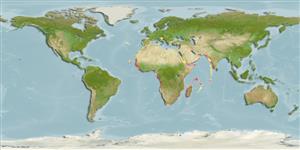Environment: milieu / climate zone / depth range / distribution range
Ecologia
marino demersale; distribuzione batimetrica 12 - 65 m (Ref. 4438). Tropical; 37°N - 36°S, 18°W - 35°E
Eastern Atlantic and Mediterranean Sea: Central to South Eastern Atlantic: Morocco, Mauritania to Congo (Ref. 33465) to Natal, South Africa (Ref. 5578); Mediterranean Sea: the records are patchy along the northern coast of Africa, and in Aegean Sea and Levantine Basin, most likely due to misidentification with other Dasyatidae spp. (Ref. 122045 and others cited).
Size / Peso / Age
Maturity: Lm ? range ? - ? cm
Max length : 74.5 cm TL maschio/sesso non determinato; (Ref. 123700)
Short description
Chiavi di identificazione | Morfologia | Morfometria
Spine dorsali (totale) : 0. Conspicuous bright blue blotches and branching lines on a golden brown disc; snout and disc angular, and tail less than twice body length with a short upper caudal finfold, and a longer lower one falling far in front of tail tip; disc without thorns; usually one sting (Ref. 5578). Underside white, tail darker and without bands (Ref. 5578).
Close inshore, found on sandy beaches and in shallow bays (Ref. 5578), sometimes near rocky reefs (Ref. 12951). Found in deeper offshore areas during the winter season (Ref. 12951). Feeds on crabs, mantis shrimps, amphipods, worms, and fishes (Ref. 12951). Ovoviviparous (Ref. 50449). Minimum depth reported from Ref. 4438. Disc width measures 30 cm. Its thorny, venomous hooks can cause painful injuries (Ref. 5377).
Life cycle and mating behavior
Maturities | Riproduzione | Spawnings | Egg(s) | Fecundities | Larve
Exhibit ovoviparity (aplacental viviparity), with embryos feeding initially on yolk, then receiving additional nourishment from the mother by indirect absorption of uterine fluid enriched with mucus, fat or protein through specialised structures (Ref. 50449). With 1 to 4 in a litter (Ref. 12951). Distinct pairing with embrace (Ref. 205).
Cowley, P.D. and L.J.V. Compagno, 1993. A taxonomic re-evaluation of the blue stingray from southern Africa (Myliobatiformes: Dasyatidae). S. Afr. J. Mar. Sci. 13:135-149. (Ref. 33465)
IUCN Red List Status (Ref. 130435)
Threat to humans
Harmless
Human uses
Pesca: di nessun interesse; Pesce da pesca sportiva: si
Strumenti
Special reports
Download XML
Fonti Internet
Estimates based on models
Preferred temperature (Ref.
123201): 20.6 - 28.1, mean 26.3 °C (based on 164 cells).
Phylogenetic diversity index (Ref.
82804): PD
50 = 0.5002 [Uniqueness, from 0.5 = low to 2.0 = high].
Bayesian length-weight: a=0.00646 (0.00265 - 0.01571), b=3.06 (2.86 - 3.26), in cm total length, based on LWR estimates for this (Sub)family-body shape (Ref.
93245).
Trophic level (Ref.
69278): 3.6 ±0.53 se; based on food items.
Resilienza (Ref.
120179): Molto basso, tempo minimo di raddoppiamento della popolazione più di 14 anni (Fec=1-4).
Fishing Vulnerability (Ref.
59153): Moderate to high vulnerability (50 of 100).
